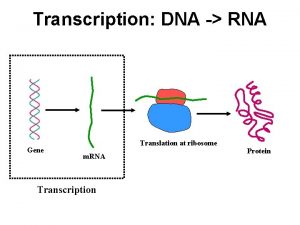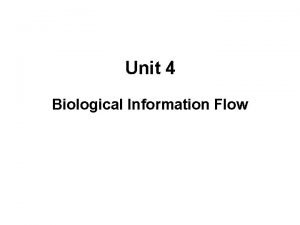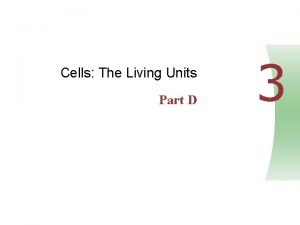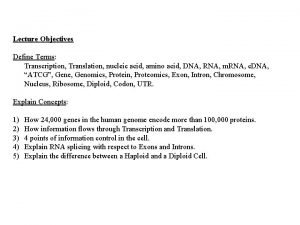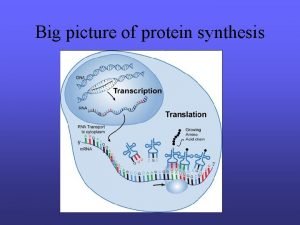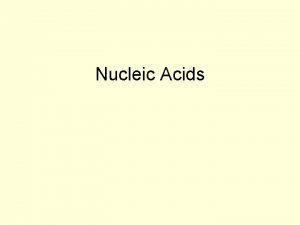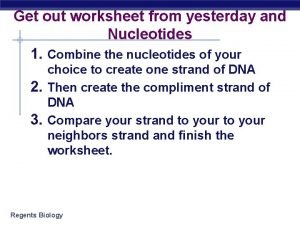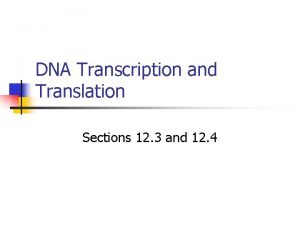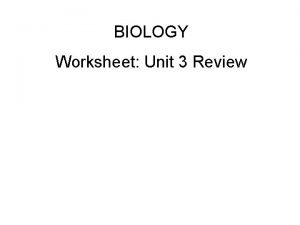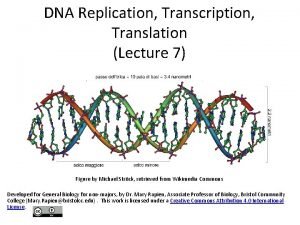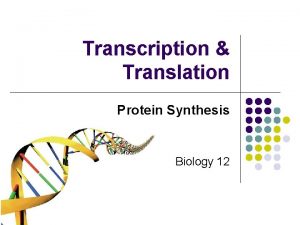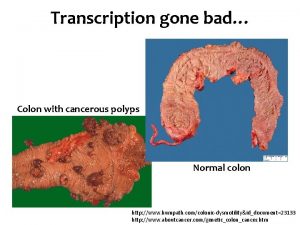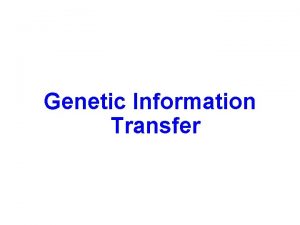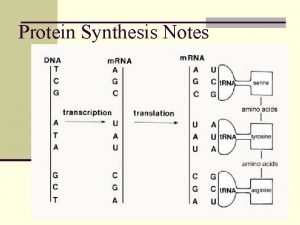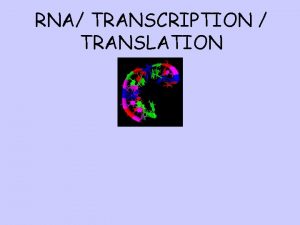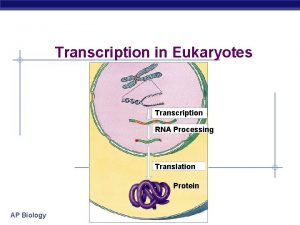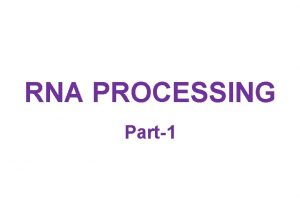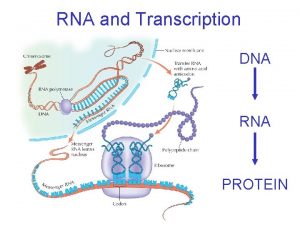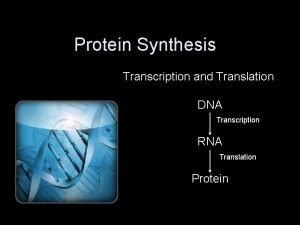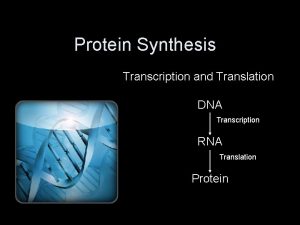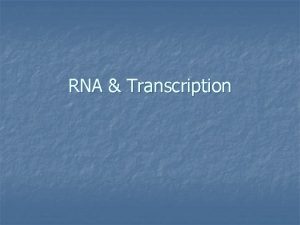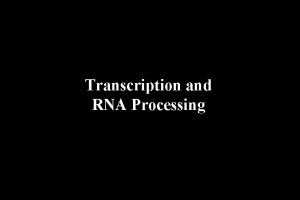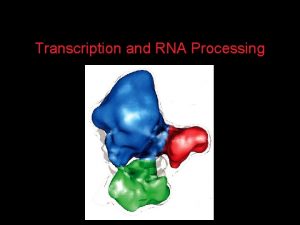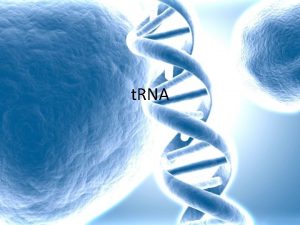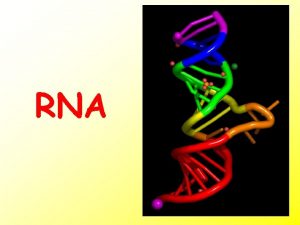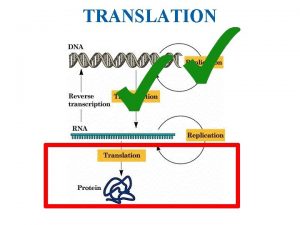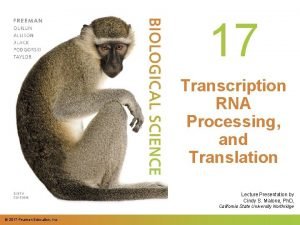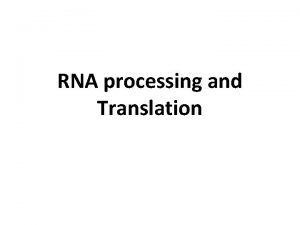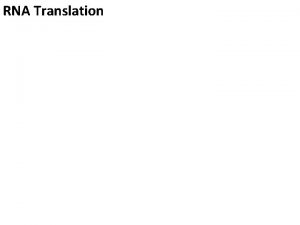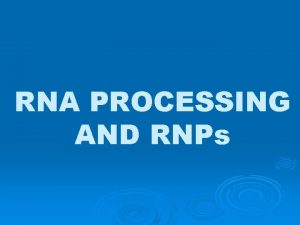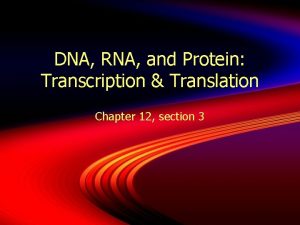Chapter 10 Transcription RNA processing Translation Jones and























- Slides: 23

Chapter 10 Transcription RNA processing Translation Jones and Bartlett Publishers © 2005

Terms (m. RNA) • • primary transcript coding sequence (open reading frame, ORF) prokaryotic m. RNA = primary transcript Eukaryotic transcripts are converted into m. RNA through RNA processing: – Modification of the 5’ end – Extension of 3’ end – Excision of untranslated embedded sequences.

The Central Dogma

Polycistronic messages • In bacteria and eukaryotic organelles, sometimes more than one polypeptide is encoded in a single message. • These are called polycistronic m. RNAs.

Polycistronic m. RNAs

Eukaryotic Transcription • In eukaryotes, three different polymerases are used. • No polycistronic m. RNAs are produced. (All eukarytoic m. RNAs are monocistronic. ) • The m. RNA molecules are chemically modified in eukaryotes.

Eukaryotic RNA Polymerases Enzyme Cellular location RNA polymerase I Nucleolus Product r. RNA polymerase II Nucleus m. RNA sn. RNA polymerase III Nucleus t. RNA, 5 S RNA, sn. RNA

Promoters for eukaryotic genes • There is more variability in promoters and termination sequences. • TATA box : 5’-TATAAA-3’, -25 bp, with GC regions near it. • CAAT box: GCCAATCT, -80 bp • GC box: GGGCGC, multiple copies.

Promoters in eukaryotes


Modification of primary transcripts • Three major alterations to m. RNA: – Modified guanosine cap at 5’ end – 3’ end gets a poly(A) tail. – pre-m. RNA is processed to remove specific internal sequences by splicing them out.

5’ cap in eukaryotes

Polyadenylation • The poly(A) tail is added by poly(A) polymerase. • About 200 adenosines are added to the 3’ end of the primary transcript. • Poly(A) tails help geneticists isolate m. RNAs from cells.

RNA Splicing • In the 1960 s, it was observed that RNA molecules were larger than predicted, based on protein structure. • In 1977, internal, non-coding sequences were discovered. • These internal, non-coding sequences are called introns.

Spliceosomes and the GU-AG rule • Intron-Exon junctions have a conserved sequence that is recognized by an enzyme complex (spliceosome). • The sequence is GU-AG, and is almost universal. • A spliceosome has nucleic acids, 8 -10 proteins, and sn. RNAs.

RNA processing Transcription and RNA processing are coupled processes.

Molecular details of the splicing of an intron Introns begin with a GU and end with an AG. There is also an internal A nucleotide where the branch junction is formed. The spliced intron is known as a lariat (with a loop and tail).

Splicing of introns is mediated by small nuclear ribonucleoprotein particles (sn. RNPs) In this diagram, only the RNA component of the sn. RNPs is shown. Base pairing between sn. RNA and the intron is involved in the splicing reaction.

DNA-RNA hybridization showing the parts of DNA that are missing from the mature m. RNA and the part of the m. RNA (poly. A tail) missing in the DNA

Mutation in a splice site may result in the retention of the entire (or part) of an intron

Exon-shuffle model • Introns may play a role in gene evolution. • In some proteins, each exon has its own independent folding characteristics. • Folding domains (=exons) can be grouped together to give new proteins with new functions. • This is called the exon-shuffle model. • Not all genes have domain boundaries that correlate to exons.

Transcription occurs in the nucleus, as does RNA processing. Export to the cytoplasm happens before translation occurs.

Translation of m. RNA into amino acid sequences • The genetic code consists of three bases. • A codon is the ‘code word’ for each amino acid. • 4 x 4 =64, but only 20 amino acids are used in proteins, so the genetic code is said to be degenerate.
 Dna to rna transcription
Dna to rna transcription Venn diagram of transcription and translation
Venn diagram of transcription and translation Rna transcription
Rna transcription Dna to rna transcription
Dna to rna transcription Dna coloring transcription and translation
Dna coloring transcription and translation Perbedaan replikasi virus dna dan rna
Perbedaan replikasi virus dna dan rna Transcription and translation bbc bitesize
Transcription and translation bbc bitesize Dna transcription and translation
Dna transcription and translation Dna replication transcription and translation
Dna replication transcription and translation Transcription and translation
Transcription and translation Transcription and translation picture
Transcription and translation picture Protein synthesis splicing
Protein synthesis splicing Biology transcription and translation
Biology transcription and translation Transcription and translation practice worksheet answer key
Transcription and translation practice worksheet answer key Venn diagram dna and rna
Venn diagram dna and rna Transcription
Transcription Transcription translation replication
Transcription translation replication Blood type chart
Blood type chart Replication transcription translation
Replication transcription translation Translation transcription
Translation transcription Transcription or translation
Transcription or translation Translation transcription
Translation transcription Semiconservative replication
Semiconservative replication Unlike dna, rna
Unlike dna, rna
